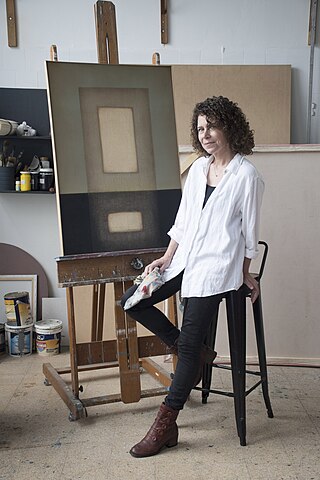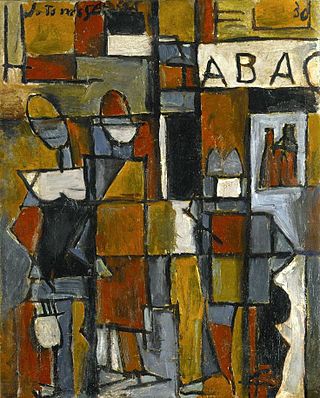Daniel Pontet | |
|---|---|
| Born | 1957 Montevideo, Uruguay |
| Nationality | American |
Daniel Pontet (born 1957) is a Uruguayan-born artist working in the U.S.
Daniel Pontet | |
|---|---|
| Born | 1957 Montevideo, Uruguay |
| Nationality | American |
Daniel Pontet (born 1957) is a Uruguayan-born artist working in the U.S.
Pontet was born in Montevideo, Uruguay, South America, in and has resided in Miami, Florida since 1991. He developed artistically in Uruguay, under watercolor painter and art teacher Esteban Garino – who taught him the art of drawing and composition - and under artists Americo Sposito and Hector Laborde, who instilled into him the magic of color and a particular emphasis on space and shapes. He also completed courses in Art History at the School of Humanities of the University of the Republic of Uruguay. Furthermore, he studied silkscreen, photography, and computer graphics as a complement to his art education and honed his skills while working at The Flyer in the mid-90s.
The earliest stage of Pontet's work can be placed within the expressionist and the neo expressionist circles and during this time he uses drawing as a fundamental element. He opens and closes spaces and organizes his balance and refuge in the canvass with grace and strength, as well as drama and lyricism. In this period, he devotes most of his energy and power of expression to depicting a world of indifferent, dauntless, and forlorn characters. Pontet stirs these meditative beings with an expressionist glare, manifesting a deep and underlying reflection on the human condition. He also creates unique rhythmical and chromatic consonances throughout these motifs. Pontet's early series share outstanding traits characterized by accomplished drawing, well thought-out compositions, mathematically precise structures, distortions and deliberate elongations, as well as the use of a rich polychrome palette of tones and hues.
Today, immersed in a new plastic period called “Metamorphosis,” Pontet is re-creating part of an enigmatic world of symbols. From realism to abstraction, Pontet's current work – teeming with feelings, thoughts, meditations, and not lacking in lyricism - is eminently plastic. His compositions, far from being descriptive, narrative or literary, are true plastic records of thoughts expressed in two- or three-dimensional surfaces. These works of art or “collages” look like accurate maps where we can find a path to think as well as reflect about our own spiritual life. This late series is also characterized by colors extracted from the soil – from brown to red oxide – and incrusted objects – keys, nails, washers, piece of fabrics, threads - which become powerful symbols and metaphors. Each symbol carries a profound spiritual message.
Daniel Pontet started exhibiting in 1975 and has participated in more than 200 art shows. He has received several prizes and acknowledgments and continues to show that his creativity has found no end. Effort and devotion are his most precious tools along with truthfulness.
As the Chilean writer Antonio Landauro once said about Daniel Pontet: “It goes without saying that this creative artist, like all genuine artists, always attains self-expression, whether he is understood, half understood, or not at all.”
Miami Dade College. Miami - FL, 1998. Honor student. Outstanding Academic Achievement. Membership at the Honor Society Phi Theta Kappa. Recognition at National Dean's List - US.

Joaquín Torres-García was a prominent Uruguayan-Spanish artist, theorist, and author, renowned for his international impact in the modern art world. Born in Montevideo, Uruguay, his family moved to Catalonia, Spain, where his artistic journey began. His career spanned several countries including Spain, New York, Italy, France, and Uruguay. A founder of art schools and groups, he notably established the first European abstract-art group, Cercle et Carré, in Paris in 1929 which included Piet Mondrian and Kandinsky. Torres-García's legacy is deeply rooted in his development of Modern Classicism and Universal Constructivism.
Virginia Patrone is an Uruguayan visual artist who worked in Uruguay before moving to Spain in 2003.
Uruguayan Americans are Americans of Uruguayan ancestry or birth. The American Community Survey of 2006 estimated the Uruguayan American population to number 50,538, a figure that notably increased a decade later.

Águeda Dicancro was a Uruguayan sculptor from Montevideo, noted for her plastic art. Her art is featured at the Museo Nacional de Artes Visuales in Montevideo.

Marco Sartor is a Uruguayan classical guitarist.

Tony Mendoza is a Cuban-American artist with a studio in Miami, Florida. Mendoza's style is Primitive Expressionist and "Caricaturista," a type of art that is whimsical in nature. Mendoza works mainly with acrylic on canvas.

Emilio Hector Rodriguez is a Cuban-American artist. His current work is abstract painting and fine art photography. He resides in Miami, Florida, USA. Rodríguez was born in the colonial village of Sancti Spíritus, Cuba, in 1950. His family moved to La Habana in 1953. He started drawing and experimenting with oil paint and tempera at the age of 12. While a student at the Instituto Pre-Universitario de Marianao, he participated in several workshops sponsored by San Alejandro Arts Academy.
Julio Uruguay Alpuy was an Uruguayan painter, sculptor, and muralist. During his early career, Alpuy was a part of the Taller Torres-García and the constructive art movement. While his early works were greatly influenced by Torres-García's theories about what he called Constructive Universalism, Alpuy drew from a wide variety of cultures and myths to create works that broke the boundaries of the constructive grid. Additionally, his studies in Europe and Latin America helped develop an interest in Cubism and myths that influenced later works. Alpuy had a prolific career and his works are exhibited throughout the world.
Amalia Polleri de Viana was a Uruguayan teacher, artist, poet, journalist, and art critic.

Eloísa Ibarra is a Uruguayan visual artist who has been recognized for her graphic works.

Cecilia Vignolo is a Uruguayan visual artist, teacher, and communicator.
Gladys Afamado is a Uruguayan visual artist, engraver, and poet. A member of the Montevideo Engraving Club since 1954, she has contributed to many of its monthly editions and almanacs. She later ventured into different plastic artforms, and in recent years has been recognized for her work in digital art.
Leonilda González was a Uruguayan painter and engraver, founder of the Montevideo Engraving Club. Her work is represented in the Juan Manuel Blanes Museum and the National Museum of Visual Arts, as well as in private collections in Uruguay and other countries. In 2006 she was recognized with the Figari Award for her career.

Nelbia Romero Cabrera was a Uruguayan visual artist. She began her career in drawing and engraving and later incorporated other artistic languages, such as photography, installation, and performance. Her work was marked by themes of politics and protest. She was an active participant in the Montevideo Engraving Club. She received a Guggenheim Fellowship in 1994 and was granted the Figari Award in 2006 for her artistic career.

Rimer Cardillo is a Uruguayan visual artist and engraver of extensive international experience who has lived in the United States since 1979.

Anhelo Hernández Ríos was a Uruguayan plastic artist and teacher.

Dumas Oroño was a Uruguayan artist, cultural manager, and teacher. His artistic work spanned several disciplines, including painting, engraving, ceramics, murals, and jewelry design.
Susana Olaondo is a Uruguayan writer and illustrator.

Universal Constructivism was a style of art created and developed by Joaquín Torres-García. Through the study and incorporation of basic geometric structure (Constructive) in the ancient and modern world creates the ability to create art that will be meaningful (Universal) to anyone who has viewed his artworks. He took the principles of Constructivism that Russian artists had developed in the 1920s and had influenced De Stijl and Bauhaus movements, and integrated what he considered to be universal pictographs, such as those for sun, moon, man, and woman. The goal of this art movement was to seek for the definition of what it means to be American by dominating constructive art and the use of primitive art that was rooted in the traditions of the continent. This style is best known for its synthesis of grid compositions and schematic signs. When Torres-García started Taller Torres Garcia in 1944, many of the participants incorporated Universal Constructivism into their own work. And later, the style influenced North American artists, such as Adolph Gottlieb and Louise Nevelson.